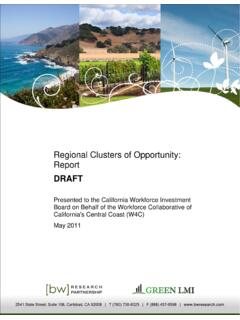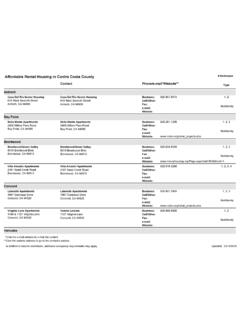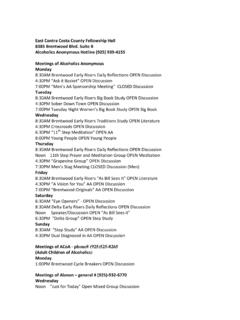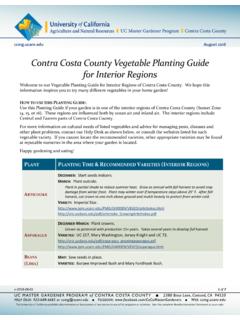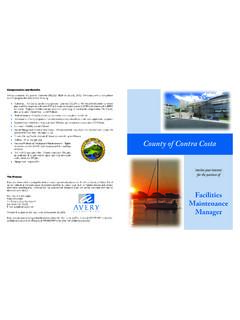Transcription of WORKFORCE DEVELOPMENT BOARD OF CONTRA COSTA …
1 WORKFORCE DEVELOPMENT BOARD OF CONTRA COSTA county LOCAL PLAN For the CCCWDB and CONTRA COSTA county Local Area (2017-2020) FEBRUARY 1, 2017 CONTRA COSTA county 2 Table of Contents Executive Summary .. 4 A. Vision, Goals, and Strategy .. 6 i. Strategic Vision for Regional Economic Growth and Self-Sufficiency .. 6 ii. Core Programs and Alignment of Resources .. 7 B. Local Program Alignment to Implement State Plan Policy Strategies .. 9 i. Description of Local WORKFORCE DEVELOPMENT System .. 9 ii. Local BOARD Support of Seven State Policy Strategies .. 11 C. Specified Services and Service Delivery Strategies .. 13 i. Core Program and Access to Employment, Training, Education and Supportive Services 13 ii. Career Pathways DEVELOPMENT and Co-Enrollment in Core Programs .. 14 iii. Post-Secondary Credentials and Industry Recognized Certifications .. 15 iv. Employer Engagement in WORKFORCE DEVELOPMENT Programs .. 16 v. Meeting the Needs of Local Business.
2 17 vi. Coordination between WORKFORCE DEVELOPMENT and Economic DEVELOPMENT .. 17 vii. Strengthen Linkages with Unemployment Insurance Programs .. 18 D. America s Job Centers of CaliforniaSM (AJCC) .. 19 i. Continuous Improvement of Eligible Service Providers .. 19 ii. Service Delivery in Remote Areas through Use of Technology (WIOA Section 188) .. 19 iii. Compliance with Americans with Disabilities Act of 1990 (42 12101 et seq.) .. 19 iv. Roles and Resource Contributions of the AJCC Partners .. 20 v. Executed MOU s and Cooperative Agreements .. 20 vi. Strategies to Provide Native Americans with Equal Access to AJCC Services (WIOA Section 166) .. 20 vii. Strategies to Provide Migrant Seasonal Farmworkers with Equal Access to AJCC Services (WIOA Section 167).. 20 viii. AJCCs as an On-Ramp for the Regional Sector Pathways .. 20 E. Programs, Populations and Partners .. 21 i. Coordination of WORKFORCE and Economic DEVELOPMENT Activities.
3 21 ii. Adult and Dislocated Worker Employment and Training Activities .. 22 iii. Coordination of Rapid Response Activities .. 23 iv. Youth WORKFORCE DEVELOPMENT Activities .. 24 v. Coordination of Education and WORKFORCE DEVELOPMENT Activities .. 26 vi. Supportive Services .. 27 vii. Maximizing Coordination with Wagner-Peyser Act Services .. 28 3 viii. Title I Coordination with Title II Adult Education and Literacy Activities .. 28 ix. Services for Limited English Proficient Individuals .. 29 F. Grants and Grant Administration .. 30 i. Disbursal of Grant Funds .. 30 ii. Competitive Process to Award Sub-Grants and Contracts .. 30 G. Performance Goals .. 30 i. Negotiated Levels of Performance .. 30 H. High Performance BOARD (HPB) Efforts .. 32 i. Compliance with State Issued AJCC Policies .. 32 I. Training Activities and Services (WIOA Section 134) .. 34 i. Individual Training Accounts and Customer Choice .. 34 J. Public Transparency, Accessibility and Inclusivity.
4 35 i. Public Comment Period .. 35 K. Common Intake and Case Management Efforts .. 36 i. Current Intake Processes and Allowance for Co-Enrollment .. 36 L. Other Miscellaneous Information .. 38 i. Title II Program Applicant Access to the Local Plan .. 38 ii. Priority of Service .. 38 iii. Portions of Local Plan in the Regional Plan Narrative .. 39 M. Local BOARD Assurances .. 39 N. Comprehensive One-Stops and AJCC Partners in the Local Area .. 39 O. AJCC Memorandums of Understanding (MOU) Attachment C .. 39 P. Local Area Grant Recipient Listing .. 39 Q. Local BOARD Bylaws .. 39 R. Program Administration Designee and Plan Signatures .. 39 S. Summary of Public Comments .. 39 Attachment A: Local BOARD Assurance .. 40 Attachment B: List of Comprehensive One-Stops and AJCC Partners in the Local Area .. 43 Attachment C: AJCC Memorandums of Understanding (MOU) .. 47 Attachment D: Local Area Grant Recipient Listing .. 59 Attachment E: Local BOARD Bylaws.
5 60 Attachment F: Program Administration Designee and Plan Signatures .. 68 Attachment E: Summary of Public Comments .. 69 4 Executive Summary The WORKFORCE DEVELOPMENT BOARD of CONTRA COSTA county (WDBCCC), whose jurisdiction includes the entire county with the exception of Richmond City, connects employers to a skilled WORKFORCE and helps individuals develop the skills needed to thrive in the workplace. The WDBCCC is a 25-member BOARD comprised of business leaders, and representatives from economic DEVELOPMENT , education, labor, community-based organizations, and public agencies. Appointed by the CONTRA COSTA county BOARD of Supervisors, members of the WORKFORCE DEVELOPMENT BOARD (WDB) are charged with shaping and strengthening local and regional WORKFORCE DEVELOPMENT efforts, and aligning assets and resources to support the enhancement of a competitive WORKFORCE . Under the WORKFORCE Innovation and Opportunity Act (WIOA), the WDBCCC is tasked with developing a four-year local plan to provide an overview of the local WORKFORCE system and describe the strategies that will be used to achieve specific goals, including fostering strategic alignment, improving service integration among WORKFORCE partners, and ensuring the WORKFORCE system is industry-relevant.
6 This local plan, in concert with a regional plan jointly developed with the other local areas in the East Bay region, will serve as the strategic roadmap for the implementation of WIOA. Strategic priorities have been identified for the four-year time frame within which it will be in effect, and the framework under which the local WORKFORCE system will operate. These priorities align with the State s three primary policy objectives articulated in California s Unified Strategic WORKFORCE DEVELOPMENT Plan. These objectives are as follows:1 1. Fostering demand-driven skills attainment WORKFORCE and education programs need to align program content with the State s industry sector needs so as to provide California s employers and businesses with the skilled WORKFORCE necessary to compete in the global economy. 2. Enabling upward mobility for all Californians, including populations with barriers to employment. WORKFORCE and education programs need to be accessible for all Californians and ensure that everyone has access to a marketable set of skills, and is able to access the level of education necessary to get a good job that ensures both economic self- sufficiency and economic security.
7 3. Aligning, coordinating, and integrating programs and services to economize limited resources to achieve scale and impact, while also providing the right services to clients, based on each client s particular and potentially unique needs, including any needs for skills DEVELOPMENT . Regional Context WDBCCC and its neighboring WDBs (in Alameda county , the City of Oakland, and the City of Richmond) together constitute the Eastbay region. This region is home to a population of million and a labor market of million in the broader Bay Area region. It is one of the most geographically concentrated areas of technology and research clusters in the world. With the second and third most populous counties in the Bay Area, Eastbay proves to be one of the largest economic drivers in the region. Relative to the larger Bay Area, Eastbay will make up an average of 28% of each of the projected total job openings in the San Francisco Bay Area Economic Market between 2012-2022.
8 1 These policy objectives can be found in Chapter 3: Comprehensive Overview of Policy Strategies (Corresponding to Strategic Planning Elements Required Under WIOA Sec. 102(b)(1)(D-E)) of the California State Unified Strategic WORKFORCE DEVELOPMENT Plan on page 73. 5 CONTRA COSTA county benefits from a distinct advantage geographically due to the strength of the economy of the region. Its proximity to San Francisco, Silicon Valley, and some of the top educational institutions in the country provide access to premier research and technological resources. The county s top in-demand private industries in terms of employment are as follows: Trade, Transportation, and Utilities; Educational and Health Services; Professional and Business Services; Goods Producing (of which 40% is in Manufacturing and 60% is in Mining, Logging, and Construction); and Leisure and Hospitality. As the third largest county in the Bay Area, CONTRA COSTA carries an estimated population of million residents.
9 Nearly of households in CONTRA COSTA live below the federal poverty line. US Census Bureau estimates show that 24% of the population is foreign-born, with 34% of the population five years and older speaking a language other than English in the household. Of foreign-born residents, most are from Asia ( ) or Latin America ( ). Resultantly, of the 34% of the population speaking a foreign language, 52% speak Spanish, speak Asian and Pacific Islander languages. WDBCCC s Vision, Mission and Strategic Direction The WORKFORCE Innovation and Opportunity Act (WIOA) encourages local boards to provide leadership and to deliver on strategies that support business competitiveness and growth, as well as strategies that assist our residents to acquire skills valued in the labor market. The WDBCCC is embracing this vision and has leveraged the creation of this local plan to develop a roadmap that will result in an aligned and responsive set of seamless services to employers and job seekers and support the economic growth and prosperity of CONTRA COSTA county .
10 It is the vision of the WDBCCC to support a network that creates and promotes dynamic education systems, high- performing business, and a prosperous local economy with an abundance of high-quality jobs and skilled workers to fill them. The WDBCCC mission is to promote a WORKFORCE DEVELOPMENT system that meets the needs of businesses, job seekers, and workers to support a strong and vibrant economy in CONTRA COSTA county . To meet the objectives set forth by the organizational vision and mission, the WDBCCC staff identified specific goals in four strategic areas: Business Services, Adult Strategies, Youth Strategies, and Administration. These goals, listed below, support the preparation of an educated and skilled WORKFORCE . Business Services Goal Enhance the competitiveness of local businesses with an emphasis on meeting the WORKFORCE needs of entrepreneurs and employers in high- demand sectors in the local and regional economy by identifying, designing, and implementing training and educational opportunities targeted to those with barriers to traditional employment to close skill gaps and enhance economic competitiveness.



